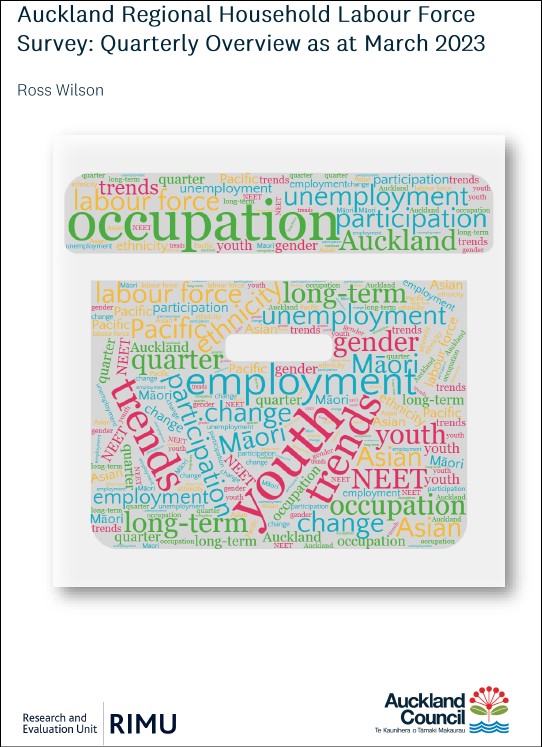Auckland regional household labour force survey: quarterly overview as at March 2023
Author:
Ross WilsonSource:
Auckland Council Research and Evaluation Unit, RIMU | Statistics New ZealandPublication date:
2023Topics:
EconomyAn overview of labour force participation in Auckland, as indicated by results of Stats NZ's quarterly Household Labour Force Survey. HLFS
Overview and highlights
For the March1 2023 quarter, compared to the preceding quarter (December 2022)2:
- Auckland’s unemployment rate was 3.4%, slightly below 3.5% in December 2022.3
This was Auckland’s lowest March unemployment rate since at least 1995. - The number of people who were unemployed fell slightly to 34,200 (-500).
- The number of people employed rose slightly to 976,900 (+6,900; full-time +8,300).
- The number of people not in the labour force (NILF) fell slightly to 347,800 (-2,400).
- The labour force participation rate rose slightly to 74.4% (December: 74.2%).
In addition, for the March 2023 quarter:
- The rate of young people aged 15 to 24 not in employment, education or training (NEET) was 11.7%, similar to December (10.8%) and the rest of New Zealand (12.8%).
Over the year ended March 2023, compared to the year ended March 2022:
- The unemployment rate averaged 3.4% for both 12-month periods.
- Unemployment for age groups 15-19 (14.5%) and 20-24 years (6.6%) had slight falls; ages 55+ (1.9%) rose slightly, and rates across other age groups changed minimally.
- The unemployment rate for females averaged 3.9%, higher than the previous year (3.5%). The rate for males averaged 2.9% (down from 3.4% a year prior), so the gap between males and females (1.0%) increased back to the 10-year average (1.1%).
- Changes in unemployment rates varied between ethnic groups: Māori unemployment rose slightly (to 7.4%), Pacific peoples fell slightly (to 6.3%) while Asian peoples (2.9%) and European peoples (2.5%) were similar to the year before.
- The labour force participation rate (LFPR) averaged 73.6%, higher than a year earlier (71.8%) and the record highest in at least 28 years.
- The labour force participation rate for females (69.0% – a record) rose significantly (up 2.2% from 66.8%); for males (a record 78.3%) it rose less (up 1.2% from 77.1%).
- Labour force participation rates rose for all age groups, especially ages 15-19 (47.4%, up 5.5% from 42.4%) and 20-24 (81.2%, up 3.4%); ages 40-54 (88.9%), 25-39 (87.3 %) and 55+ (51.5%), all rose slightly, to record highs.
- Labour force participation rates rose for all ethnicities, especially Asian (77.6%, a 2.2% rise), but also European (74.4%, up 1.3%), Māori (68.9%, up 1.2%) and Pacific (67.1%, up 1.0%). All groups were at record levels except Māori (69.9% in June 2018).
In addition, over the year ended March 2023:
- The annual average NEET rate for Auckland was 11.0%, similar to the rest of New Zealand (11.3%), and slightly below the year ended March 2022 (11.9%).
- Auckland’s NEET rate had fully recovered (fallen) to pre-pandemic levels 2016-2019.
Auckland NEET rates were highest for Māori (19.4%) and Pacific (16.1%) ethnicities, Southern Initiative area (18.4%), and those aged 20 to 24 years (13.6%).
________________________________________________________________
1. See note in the Introduction regarding impact of floods and Cyclone Gabrielle
2. Results are not seasonally adjusted, and include Stats NZ revisions (usually minor) of previous periods’ data.
3. The definition of ‘similar/slightly’ or ‘different’ is relative to survey sampling error margins produced by Stats NZ. For further details see ‘Significant difference’ in Appendix 1.
Overview published May 2023.
